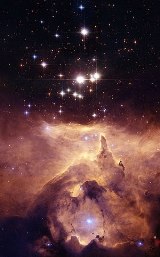
NGC 6357
Encyclopedia
NGC 6357 is a diffuse nebula near NGC 6334
in the constellation
Scorpius. This nebula was given the name War and Peace Nebula by the Midcourse Space Experiment
scientists because of its appearance. They said that in infrared images the bright, western part resembles a dove, while the eastern part looks like a skull. The nebula contains many proto-stars shielded by dark disks of gas, and young stars wrapped in expanding "cocoons".
, was thought possibly to be the most massive on record, approaching 300 solar masses, until it was discovered to be a binary system with each star exceeding 100 solar masses.
NGC 6334
NGC 6334 is an emission nebula located in the constellation Scorpius. It was discovered by astronomer John Herschel in 1837, who observed it from the Cape of Good Hope in South Africa.-External links:* — ESO Photo Release*Astronomy Picture of the Day - 2010 April 21...
in the constellation
Constellation
In modern astronomy, a constellation is an internationally defined area of the celestial sphere. These areas are grouped around asterisms, patterns formed by prominent stars within apparent proximity to one another on Earth's night sky....
Scorpius. This nebula was given the name War and Peace Nebula by the Midcourse Space Experiment
Midcourse Space Experiment
The Midcourse Space Experiment is a Ballistic Missile Defense Organization satellite experiment to map bright infrared sources in space...
scientists because of its appearance. They said that in infrared images the bright, western part resembles a dove, while the eastern part looks like a skull. The nebula contains many proto-stars shielded by dark disks of gas, and young stars wrapped in expanding "cocoons".
Pismis 24
This nebula includes the open cluster Pismis 24, which is home to several massive stars. One of the brightest stars in the cluster, Pismis 24-1Pismis 24-1
Pismis 24-1 is part of the open cluster Pismis 24 within the nebula NGC 6357 about 8150 light-years away. Pismis 24-1 is the largest and more brilliant of the visible stars of this cluster, and is one of the most massive and luminous stars known...
, was thought possibly to be the most massive on record, approaching 300 solar masses, until it was discovered to be a binary system with each star exceeding 100 solar masses.
External links
- APODAstronomy Picture of the DayAstronomy Picture of the Day is a website provided by NASA and Michigan Technological University . According to the website, "Each day a different image or photograph of our universe is featured, along with a brief explanation written by a professional astronomer."The photograph is not necessarily...
Pictures:
- A Massive Star in NGC 6357 with a close-up of Pismis 24.
- Star Forming Region NGC 6357 showing complex interactions between interstellar winds, radiation pressures and magnetic fields.

